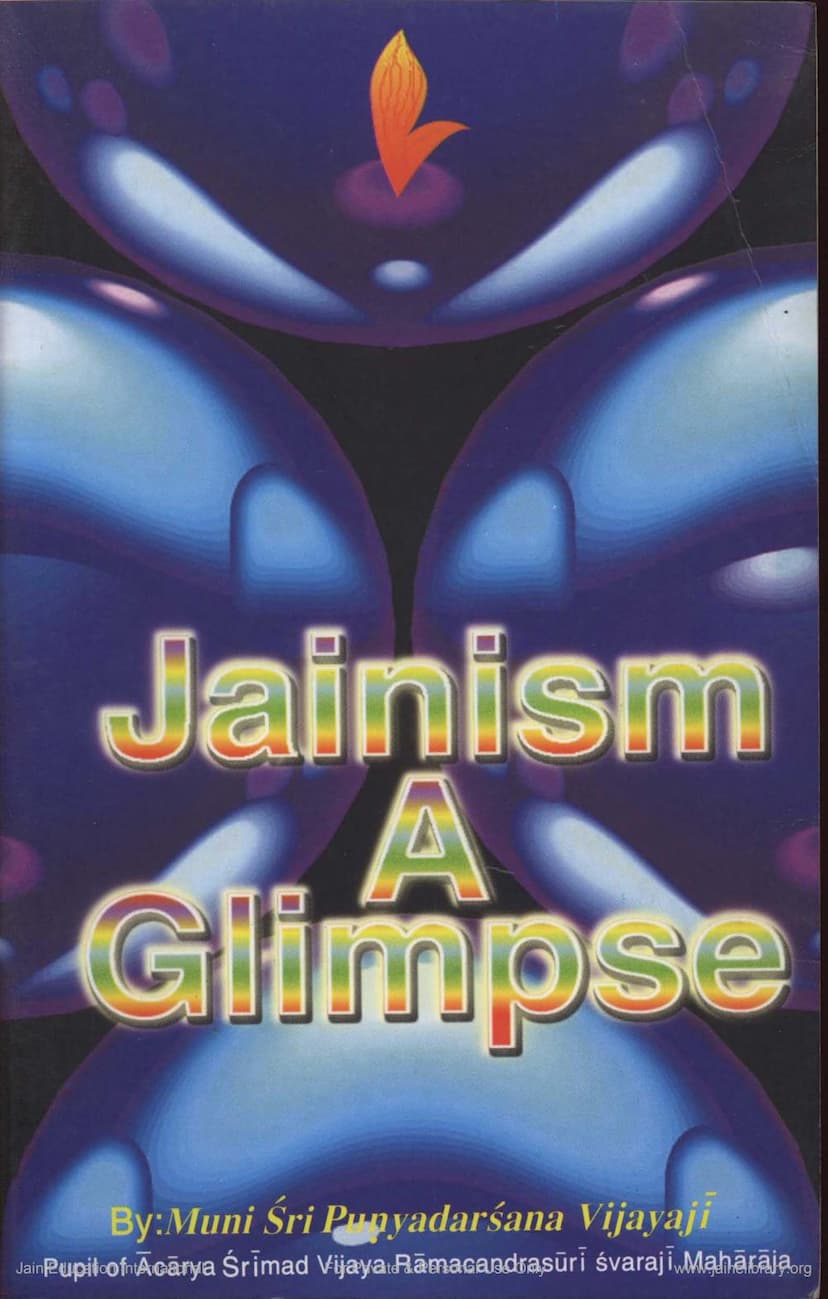Jainism A Glimpse
Added to library: September 2, 2025

Summary
This document is a comprehensive overview of Jainism, titled "Jainism: A Glimpse," authored by Muni Sri Punyadarshan Vijayaji. Published by Sanmarg Prakashan, it serves as an introductory text for both Jains born in foreign countries and non-Jains.
The book aims to provide a foundational understanding of Jain philosophy, emphasizing its extensiveness and importance. It highlights Jainism's dynamic view of the soul and its potential for moral and spiritual upliftment, contrasting it with materialistic advancements. The text positions Jainism's philosophy of relativity as a means to foster harmony among conflicting ideologies, promoting understanding and mutual appreciation.
Key concepts covered include:
- Concept of God: Jainism acknowledges God not as a creator but as a state of pure, liberated soul (Siddhatva) possessing infinite knowledge and bliss. It emphasizes individual mastery over one's destiny.
- Cosmology and Creation: The universe is considered eternal, uncreated, and governed by its own laws. It is composed of six fundamental substances (Dravyas): Jiva (soul), Pudgala (matter), Dharmastikāya (medium of motion), Adharmastikāya (medium of rest), Ākāśa (space), and Kāla (time).
- The Soul (Jiva): The soul is immortal, conscious, and possesses infinite inherent qualities (Gunas) that are obscured by karmic matter. It undergoes cycles of birth and rebirth across four states of existence (Gati): celestial, infernal, sub-human, and human.
- Karma Doctrine: The core of Jain philosophy, explaining how actions (thought, speech, or deed) attract subtle particles of matter (Karma) that bind the soul, obscuring its natural qualities. Liberation (Moksha) is achieved by eradicating this karmic matter through various spiritual practices.
- States of Existence (Gati): The book details the four states, emphasizing the human condition as the most precious for spiritual progress.
- Leshya: A concept describing the state of mind and its influence on karmic energies, categorized into six types (Black, Dark, Grey, Fiery Red, Lotus Pink, White).
- Three Jewels (Triratna): Right Faith (Samyak Darshana), Right Knowledge (Samyak Jnana), and Right Conduct (Samyak Charitra) are presented as the path to liberation.
- Jaina Monkhood: The rigorous lifestyle of Jaina monks is described, highlighting their adherence to vows, detachment, and reverence for all life forms.
- Ahimsa, Samyama, and Tapa: These three divine qualities—Non-violence, Renunciation, and Penance—are central to Jain spiritual practice. Ahimsa is explained as the supreme religion, encompassing reverence for all life.
- Vows (Mahavrata and Anuvrata): The five great vows for monks and the lesser vows for lay followers are outlined, emphasizing strict adherence in thought, word, and deed.
- Life Forces (Prana): The ten life forces that animate a soul within a body are mentioned, highlighting that any harm to these constitutes violence.
- Nigoda: The concept of the lowest form of life, dwelling in immense numbers and having extremely short lifespans, is discussed in relation to the vastness of life in the universe.
- Samitis and Guptis: Five types of watchfulness and three types of restraints are essential for Jaina monks to minimize harm.
- Sangha: The spiritual community, comprising monks, nuns, laymen, and laywomen, is described, with emphasis on genuine spiritual aspiration for liberation.
- Rules of Conduct (Mārgānusāri): Thirty-five ethical rules for social and personal life are presented, based on love, sympathy, and virtue, guiding individuals towards spiritual progress.
- Tapa (Penance): Twelve types of penances (six external and six internal) are detailed as methods to purify the soul by eradicating karmic matter. Bhagavan Mahavir's ascetic life is cited as an example of extreme penance.
- Syadvada (Philosophy of Relativity): Also known as Anekantavada, this doctrine emphasizes that truth is manifold and can only be understood by considering multiple perspectives. It is seen as a tool for fostering harmony.
- Kevalajnana and Kevaladarshana: Omniscient knowledge and vision, possessed by liberated souls, are described as understanding the minutest units of time (Samaya) and matter (Paramanu). The text draws parallels with modern scientific discoveries about subatomic particles.
- Kala (Time): The concept of time is explored, including the calculation of vast periods like Palyopama and Sagaropama, and the cyclical nature of time (Kalachakra).
- Pudgala (Matter): Matter is described as having form and various attributes (color, smell, taste, touch, shape), and its indivisible particle, Paramānu, is discussed in the context of modern science.
- Vargana: Categories of matter that play a significant role in the soul's experiences of suffering and enjoyment are outlined, with eight primary categories mentioned.
- Agama Scriptures: The tradition of oral transmission and later written compilation of Jain scriptures is discussed, highlighting the complexity and depth of the teachings.
- Queries Clarified: The latter part of the book addresses common questions about Jain beliefs, such as the concept of God, predestination, the existence of celestial and infernal beings, the origin of Jain teachings, the absence of commandments, and the reasons for a limited number of followers.
In essence, "Jainism: A Glimpse" presents Jainism as a profound philosophical and scientific system, rooted in cosmic principles and dedicated to the spiritual upliftment and ultimate liberation of every soul through ethical conduct, self-discipline, and reverence for life.